A Portrait of Canadian Youth: March 2019 Updates
Archived Content
Information identified as archived is provided for reference, research or recordkeeping purposes. It is not subject to the Government of Canada Web Standards and has not been altered or updated since it was archived. Please "contact us" to request a format other than those available.
March 2019
- Who are Canadian youth and where do they live?
- What are Canadian youth doing?
- How are Canadian youth doing?
- What's next?
Today's youth are unlike any generation before!
They are more:
- Diverse
- Connected
- Socially Engaged
- Educated
Many youth are reaping the benefits but others face challenges such as...
- finding a full time job
- social exclusion
- cyberbullying
- mental health challenges and addiction
- higher risk of being obese
Also important to think about today's youth within the entire life course.
It is important to remember that today's youth will become Canada's future parents, prime-age workers, and seniors. Their early experiences and vulnerabilities can shape their outcomes later in life.
Who are Canadian youth and where do they live?
Canadian youth in numbers
There are over 7 million youth across the country, aged 15 to 29.

Description for Chart 1
| Age category | Percentage of youth |
|---|---|
| Source: Statistics Canada, 2018 Demographic Estimates Program (preliminary estimates). | |
| 15 to 19 | 30 |
| 20 to 24 years | 34 |
| 25 to 29 years | 36 |
In July 2018, 15-29 year-olds represented 19.2% of the country's population. Medium growth population projections suggest that this proportion will fall to 18% by 2035.
Between 2008 and 2018, the number of youth aged 25 to 29 increased the most. The number of youth aged 15 to 19 declined.
Did you know?
Similar to other countries, Canada's youth represent a smaller share of the population than in the past.
Youth's share of the population highest in Western Canada and the North
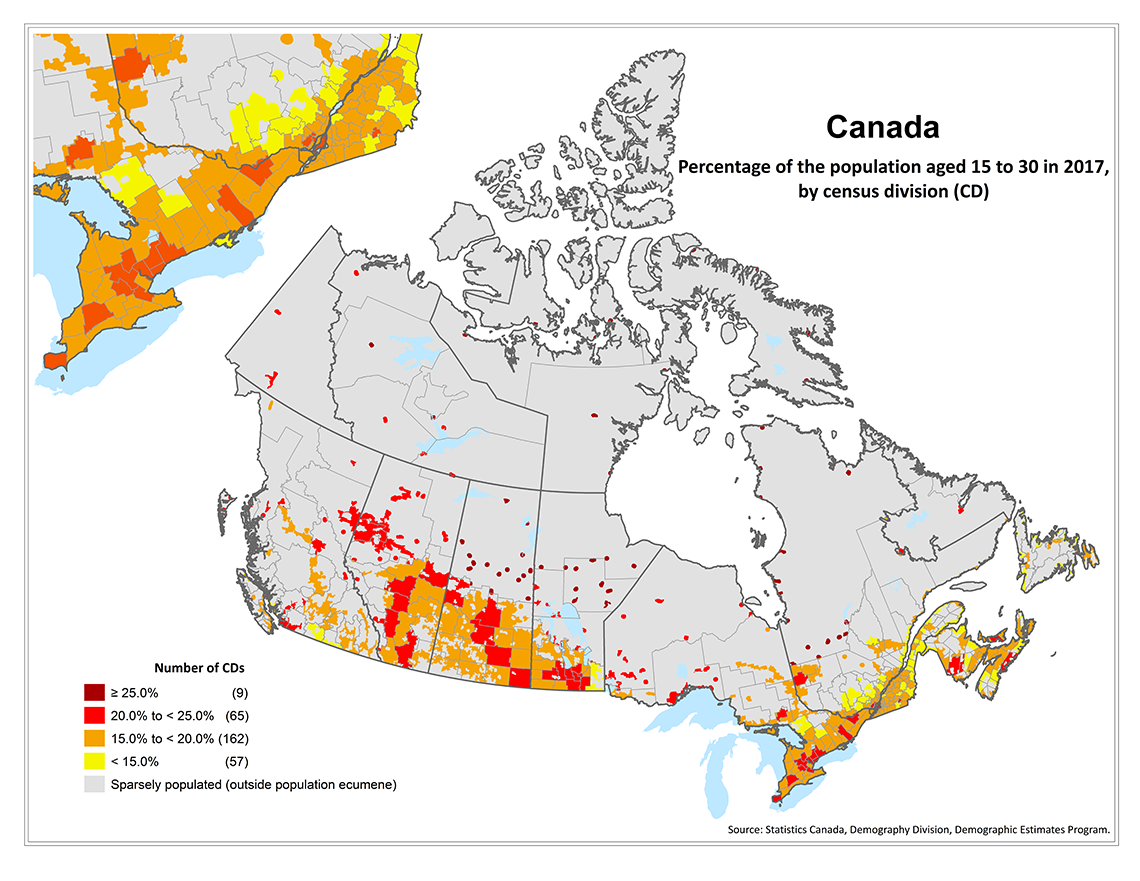
Description for Map 1
| Province or Territory | Census Division | Proportion of the population aged 15 to 30 in 2017 |
|---|---|---|
| Newfoundland and Labrador | 1001 Division No. 1 | 19.7% |
| Newfoundland and Labrador | 1002 Division No. 2 | 14.1% |
| Newfoundland and Labrador | 1003 Division No. 3 | 12.7% |
| Newfoundland and Labrador | 1004 Division No. 4 | 14.5% |
| Newfoundland and Labrador | 1005 Division No. 5 | 17.2% |
| Newfoundland and Labrador | 1006 Division No. 6 | 16.1% |
| Newfoundland and Labrador | 1007 Division No. 7 | 13.5% |
| Newfoundland and Labrador | 1008 Division No. 8 | 12.4% |
| Newfoundland and Labrador | 1009 Division No. 9 | 12.5% |
| Newfoundland and Labrador | 1010 Division No. 10 | 20.8% |
| Newfoundland and Labrador | 1011 Division No. 11 | 24.3% |
| Prince Edward Island | 1101 Kings | 17.6% |
| Prince Edward Island | 1102 Queens | 20.6% |
| Prince Edward Island | 1103 Prince | 17.2% |
| Nova Scotia | 1201 Shelburne | 15.4% |
| Nova Scotia | 1202 Yarmouth | 16.6% |
| Nova Scotia | 1203 Digby | 14.5% |
| Nova Scotia | 1204 Queens | 13.4% |
| Nova Scotia | 1205 Annapolis | 14.3% |
| Nova Scotia | 1206 Lunenburg | 14.5% |
| Nova Scotia | 1207 Kings | 18.3% |
| Nova Scotia | 1208 Hants | 17.1% |
| Nova Scotia | 1209 Halifax | 22.6% |
| Nova Scotia | 1210 Colchester | 17.6% |
| Nova Scotia | 1211 Cumberland | 15.3% |
| Nova Scotia | 1212 Pictou | 16.0% |
| Nova Scotia | 1213 Guysborough | 11.7% |
| Nova Scotia | 1214 Antigonish | 18.9% |
| Nova Scotia | 1215 Inverness | 16.0% |
| Nova Scotia | 1216 Richmond | 15.3% |
| Nova Scotia | 1217 Cape Breton | 17.7% |
| Nova Scotia | 1218 Victoria | 14.3% |
| New Brunswick | 1301 Saint John | 19.3% |
| New Brunswick | 1302 Charlotte | 15.9% |
| New Brunswick | 1303 Sunbury | 22.7% |
| New Brunswick | 1304 Queens | 12.8% |
| New Brunswick | 1305 Kings | 17.5% |
| New Brunswick | 1306 Albert | 17.1% |
| New Brunswick | 1307 Westmorland | 18.8% |
| New Brunswick | 1308 Kent | 14.2% |
| New Brunswick | 1309 Northumberland | 15.8% |
| New Brunswick | 1310 York | 21.0% |
| New Brunswick | 1311 Carleton | 17.6% |
| New Brunswick | 1312 Victoria | 15.5% |
| New Brunswick | 1313 Madawaska | 14.5% |
| New Brunswick | 1314 Restigouche | 15.1% |
| New Brunswick | 1315 Gloucester | 14.5% |
| Quebec | 2401 Les Îles-de-la-Madeleine | 13.7% |
| Quebec | 2402 Le Rocher-Percé | 12.8% |
| Quebec | 2403 La Côte-de-Gaspé | 15.1% |
| Quebec | 2404 La Haute-Gaspésie | 12.7% |
| Quebec | 2405 Bonaventure | 13.9% |
| Quebec | 2406 Avignon | 14.6% |
| Quebec | 2407 La Matapédia | 15.0% |
| Quebec | 2408 Matane | 14.1% |
| Quebec | 2409 La Mitis | 14.2% |
| Quebec | 2410 Rimouski-Neigette | 17.4% |
| Quebec | 2411 Les Basques | 11.6% |
| Quebec | 2412 Rivière-du-Loup | 16.6% |
| Quebec | 2413 Témiscouata | 13.2% |
| Quebec | 2414 Kamouraska | 14.6% |
| Quebec | 2415 Charlevoix-Est | 13.8% |
| Quebec | 2416 Charlevoix | 13.5% |
| Quebec | 2417 L'Islet | 13.4% |
| Quebec | 2418 Montmagny | 14.8% |
| Quebec | 2419 Bellechasse | 16.7% |
| Quebec | 2420 L'Île-d'Orléans | 14.4% |
| Quebec | 2421 La Côte-de-Beaupré | 14.9% |
| Quebec | 2422 La Jacques-Cartier | 17.2% |
| Quebec | 2423 Québec | 19.9% |
| Quebec | 2425 Lévis | 17.7% |
| Quebec | 2426 La Nouvelle-Beauce | 18.1% |
| Quebec | 2427 Robert-Cliche | 16.2% |
| Quebec | 2428 Les Etchemins | 14.3% |
| Quebec | 2429 Beauce-Sartigan | 17.4% |
| Quebec | 2430 Le Granit | 14.5% |
| Quebec | 2431 Les Appalaches | 14.5% |
| Quebec | 2432 L'Érable | 16.4% |
| Quebec | 2433 Lotbinière | 18.1% |
| Quebec | 2434 Portneuf | 15.4% |
| Quebec | 2435 Mékinac | 11.1% |
| Quebec | 2436 Shawinigan | 14.7% |
| Quebec | 2437 Francheville | 18.4% |
| Quebec | 2438 Bécancour | 15.8% |
| Quebec | 2439 Arthabaska | 16.8% |
| Quebec | 2440 Les Sources | 13.4% |
| Quebec | 2441 Le Haut-Saint-François | 15.1% |
| Quebec | 2442 Le Val-Saint-François | 15.6% |
| Quebec | 2443 Sherbrooke | 22.2% |
| Quebec | 2444 Coaticook | 17.8% |
| Quebec | 2445 Memphrémagog | 13.5% |
| Quebec | 2446 Brome-Missisquoi | 15.1% |
| Quebec | 2447 La Haute-Yamaska | 17.0% |
| Quebec | 2448 Acton | 16.4% |
| Quebec | 2449 Drummond | 17.8% |
| Quebec | 2450 Nicolet-Yamaska | 16.6% |
| Quebec | 2451 Maskinongé | 13.6% |
| Quebec | 2452 D'Autray | 16.8% |
| Quebec | 2453 Pierre-De Saurel | 14.8% |
| Quebec | 2454 Les Maskoutains | 18.3% |
| Quebec | 2455 Rouville | 17.8% |
| Quebec | 2456 Le Haut-Richelieu | 18.3% |
| Quebec | 2457 La Vallée-du-Richelieu | 17.0% |
| Quebec | 2458 Longueuil | 18.4% |
| Quebec | 2459 Marguerite-D'Youville | 18.7% |
| Quebec | 2460 L'Assomption | 18.4% |
| Quebec | 2461 Joliette | 17.2% |
| Quebec | 2462 Matawinie | 13.7% |
| Quebec | 2463 Montcalm | 19.2% |
| Quebec | 2464 Les Moulins | 18.8% |
| Quebec | 2465 Laval | 19.2% |
| Quebec | 2466 Montréal | 22.2% |
| Quebec | 2467 Roussillon | 19.0% |
| Quebec | 2468 Les Jardins-de-Napierville | 19.6% |
| Quebec | 2469 Le Haut-Saint-Laurent | 16.9% |
| Quebec | 2470 Beauharnois-Salaberry | 18.4% |
| Quebec | 2471 Vaudreuil-Soulanges | 17.6% |
| Quebec | 2472 Deux-Montagnes | 17.8% |
| Quebec | 2473 Thérèse-De Blainville | 20.5% |
| Quebec | 2474 Mirabel | 21.0% |
| Quebec | 2475 La Rivière-du-Nord | 18.5% |
| Quebec | 2476 Argenteuil | 15.5% |
| Quebec | 2477 Les Pays-d'en-Haut | 12.0% |
| Quebec | 2478 Les Laurentides | 14.0% |
| Quebec | 2479 Antoine-Labelle | 13.8% |
| Quebec | 2480 Papineau | 14.1% |
| Quebec | 2481 Gatineau | 20.3% |
| Quebec | 2482 Les Collines-de-l'Outaouais | 16.6% |
| Quebec | 2483 La Vallée-de-la-Gatineau | 14.4% |
| Quebec | 2484 Pontiac | 16.3% |
| Quebec | 2485 Témiscamingue | 15.3% |
| Quebec | 2486 Rouyn-Noranda | 20.1% |
| Quebec | 2487 Abitibi-Ouest | 16.3% |
| Quebec | 2488 Abitibi | 18.3% |
| Quebec | 2489 La Vallée-de-l'Or | 19.2% |
| Quebec | 2490 La Tuque | 17.3% |
| Quebec | 2491 Le Domaine-du-Roy | 16.0% |
| Quebec | 2492 Maria-Chapdelaine | 14.6% |
| Quebec | 2493 Lac-Saint-Jean-Est | 16.2% |
| Quebec | 2494 Le Saguenay-et-son-Fjord | 17.4% |
| Quebec | 2495 La Haute-Côte-Nord | 13.4% |
| Quebec | 2496 Manicouagan | 16.7% |
| Quebec | 2497 Sept-Rivières--Caniapiscau | 18.8% |
| Quebec | 2498 Minganie--Le Golfe-du-Saint-Laurent | 16.7% |
| Quebec | 2499 Nord-du-Québec | 25.3% |
| Ontario | 3501 Stormont, Dundas and Glengarry | 17.7% |
| Ontario | 3502 Prescott and Russell | 17.7% |
| Ontario | 3506 Ottawa | 22.4% |
| Ontario | 3507 Leeds and Grenville | 16.5% |
| Ontario | 3509 Lanark | 16.5% |
| Ontario | 3510 Frontenac | 21.8% |
| Ontario | 3511 Lennox and Addington | 16.4% |
| Ontario | 3512 Hastings | 18.1% |
| Ontario | 3513 Prince Edward | 13.8% |
| Ontario | 3514 Northumberland | 16.0% |
| Ontario | 3515 Peterborough | 19.4% |
| Ontario | 3516 Kawartha Lakes | 16.4% |
| Ontario | 3518 Durham | 20.9% |
| Ontario | 3519 York | 20.7% |
| Ontario | 3520 Toronto | 23.5% |
| Ontario | 3521 Peel | 23.2% |
| Ontario | 3522 Dufferin | 20.6% |
| Ontario | 3523 Wellington | 21.6% |
| Ontario | 3524 Halton | 19.1% |
| Ontario | 3525 Hamilton | 21.4% |
| Ontario | 3526 Niagara | 19.5% |
| Ontario | 3528 Haldimand-Norfolk | 18.4% |
| Ontario | 3529 Brant | 19.8% |
| Ontario | 3530 Waterloo | 23.0% |
| Ontario | 3531 Perth | 19.8% |
| Ontario | 3532 Oxford | 19.3% |
| Ontario | 3534 Elgin | 18.3% |
| Ontario | 3536 Chatham-Kent | 18.1% |
| Ontario | 3537 Essex | 20.8% |
| Ontario | 3538 Lambton | 18.2% |
| Ontario | 3539 Middlesex | 22.7% |
| Ontario | 3540 Huron | 18.2% |
| Ontario | 3541 Bruce | 16.5% |
| Ontario | 3542 Grey | 17.1% |
| Ontario | 3543 Simcoe | 19.6% |
| Ontario | 3544 Muskoka | 16.5% |
| Ontario | 3546 Haliburton | 12.4% |
| Ontario | 3547 Renfrew | 18.4% |
| Ontario | 3548 Nipissing | 19.6% |
| Ontario | 3549 Parry Sound | 14.5% |
| Ontario | 3551 Manitoulin | 16.3% |
| Ontario | 3552 Sudbury | 15.6% |
| Ontario | 3553 Greater Sudbury | 20.2% |
| Ontario | 3554 Timiskaming | 17.5% |
| Ontario | 3556 Cochrane | 19.2% |
| Ontario | 3557 Algoma | 17.3% |
| Ontario | 3558 Thunder Bay | 20.1% |
| Ontario | 3559 Rainy River | 18.6% |
| Ontario | 3560 Kenora | 22.2% |
| Manitoba | 4601 Division No. 1 | 14.4% |
| Manitoba | 4602 Division No. 2 | 22.8% |
| Manitoba | 4603 Division No. 3 | 22.9% |
| Manitoba | 4604 Division No. 4 | 18.8% |
| Manitoba | 4605 Division No. 5 | 16.7% |
| Manitoba | 4606 Division No. 6 | 19.5% |
| Manitoba | 4607 Division No. 7 | 22.8% |
| Manitoba | 4608 Division No. 8 | 21.2% |
| Manitoba | 4609 Division No. 9 | 20.7% |
| Manitoba | 4610 Division No. 10 | 20.6% |
| Manitoba | 4611 Division No. 11 | 23.1% |
| Manitoba | 4612 Division No. 12 | 18.6% |
| Manitoba | 4613 Division No. 13 | 19.2% |
| Manitoba | 4614 Division No. 14 | 20.2% |
| Manitoba | 4615 Division No. 15 | 15.9% |
| Manitoba | 4616 Division No. 16 | 18.8% |
| Manitoba | 4617 Division No. 17 | 17.1% |
| Manitoba | 4618 Division No. 18 | 17.1% |
| Manitoba | 4619 Division No. 19 | 24.5% |
| Manitoba | 4620 Division No. 20 | 18.0% |
| Manitoba | 4621 Division No. 21 | 22.7% |
| Manitoba | 4622 Division No. 22 | 26.9% |
| Manitoba | 4623 Division No. 23 | 26.3% |
| Saskatchewan | 4701 Division No. 1 | 20.3% |
| Saskatchewan | 4702 Division No. 2 | 18.8% |
| Saskatchewan | 4703 Division No. 3 | 15.8% |
| Saskatchewan | 4704 Division No. 4 | 18.9% |
| Saskatchewan | 4705 Division No. 5 | 17.4% |
| Saskatchewan | 4706 Division No. 6 | 22.2% |
| Saskatchewan | 4707 Division No. 7 | 18.9% |
| Saskatchewan | 4708 Division No. 8 | 19.0% |
| Saskatchewan | 4709 Division No. 9 | 17.6% |
| Saskatchewan | 4710 Division No. 10 | 17.0% |
| Saskatchewan | 4711 Division No. 11 | 23.7% |
| Saskatchewan | 4712 Division No. 12 | 17.4% |
| Saskatchewan | 4713 Division No. 13 | 19.4% |
| Saskatchewan | 4714 Division No. 14 | 17.5% |
| Saskatchewan | 4715 Division No. 15 | 20.6% |
| Saskatchewan | 4716 Division No. 16 | 19.2% |
| Saskatchewan | 4717 Division No. 17 | 23.0% |
| Saskatchewan | 4718 Division No. 18 | 27.4% |
| Alberta | 4801 Division No. 1 | 19.6% |
| Alberta | 4802 Division No. 2 | 22.7% |
| Alberta | 4803 Division No. 3 | 18.6% |
| Alberta | 4804 Division No. 4 | 17.6% |
| Alberta | 4805 Division No. 5 | 19.1% |
| Alberta | 4806 Division No. 6 | 21.3% |
| Alberta | 4807 Division No. 7 | 19.2% |
| Alberta | 4808 Division No. 8 | 21.3% |
| Alberta | 4809 Division No. 9 | 19.6% |
| Alberta | 4810 Division No. 10 | 19.1% |
| Alberta | 4811 Division No. 11 | 22.7% |
| Alberta | 4812 Division No. 12 | 22.1% |
| Alberta | 4813 Division No. 13 | 18.0% |
| Alberta | 4814 Division No. 14 | 19.9% |
| Alberta | 4815 Division No. 15 | 23.2% |
| Alberta | 4816 Division No. 16 | 23.4% |
| Alberta | 4817 Division No. 17 | 23.4% |
| Alberta | 4818 Division No. 18 | 21.1% |
| Alberta | 4819 Division No. 19 | 22.9% |
| British Columbia | 5901 East Kootenay | 16.9% |
| British Columbia | 5903 Central Kootenay | 15.4% |
| British Columbia | 5905 Kootenay Boundary | 14.7% |
| British Columbia | 5907 Okanagan-Similkameen | 13.8% |
| British Columbia | 5909 Fraser Valley | 20.1% |
| British Columbia | 5915 Greater Vancouver | 22.2% |
| British Columbia | 5917 Capital | 19.9% |
| British Columbia | 5919 Cowichan Valley | 15.5% |
| British Columbia | 5921 Nanaimo | 16.4% |
| British Columbia | 5923 Alberni-Clayoquot | 17.2% |
| British Columbia | 5924 Strathcona | 16.2% |
| British Columbia | 5926 Comox Valley | 15.3% |
| British Columbia | 5927 Powell River | 13.6% |
| British Columbia | 5929 Sunshine Coast | 12.4% |
| British Columbia | 5931 Squamish-Lillooet | 21.2% |
| British Columbia | 5933 Thompson-Nicola | 19.6% |
| British Columbia | 5935 Central Okanagan | 19.8% |
| British Columbia | 5937 North Okanagan | 16.1% |
| British Columbia | 5939 Columbia-Shuswap | 15.1% |
| British Columbia | 5941 Cariboo | 16.9% |
| British Columbia | 5943 Mount Waddington | 17.1% |
| British Columbia | 5945 Central Coast | 17.9% |
| British Columbia | 5947 Skeena-Queen Charlotte | 20.4% |
| British Columbia | 5949 Kitimat-Stikine | 20.2% |
| British Columbia | 5951 Bulkley-Nechako | 19.6% |
| British Columbia | 5953 Fraser-Fort George | 22.1% |
| British Columbia | 5955 Peace River | 23.7% |
| British Columbia | 5957 Stikine | 16.7% |
| British Columbia | 5959 Northern Rockies | 20.7% |
| Yukon | 6001 Yukon | 20.1% |
| Northwest Territories | 6101 Region 1 | 24.0% |
| Northwest Territories | 6102 Region 2 | 26.0% |
| Northwest Territories | 6103 Region 3 | 27.0% |
| Northwest Territories | 6104 Region 4 | 23.0% |
| Northwest Territories | 6105 Region 5 | 22.5% |
| Northwest Territories | 6106 Region 6 | 23.5% |
| Nunavut | 6204 Baffin | 26.0% |
| Nunavut | 6205 Keewatin | 28.9% |
| Nunavut | 6208 Kitikmeot | 27.7% |
| Source: Statistics Canada, 2017, Demographic Estimates Program (preliminary estimates). | ||

Description for Chart 2
| Province or territory | Percentage of youth |
|---|---|
| Source: Statistics Canada, 2017, Demographic Estimates Program (preliminary estimates). | |
| Canada | 15 |
| Newfoundland and Laborador | 39 |
| Prince Edward Island | 38 |
| Nova Scotia | 28 |
| New Brunswick | 34 |
| Quebec | 16 |
| Ontario | 9 |
| Manitoba | 29 |
| Saskatchewan | 33 |
| Alberta | 16 |
| British Columbia | 10 |
| Yukon | 23 |
| North West Territories | 51 |
| Nunavut | 100 |
Youth are highly diverse
In 2016, 27% of youth aged 15 to 30 were identified as members of a visible minority group, compared with 13% in 1996.

Description for Chart 3
| 1996 | 2016 | |
|---|---|---|
| Sources: Statistics Canada, 1996 and 2016 Census. | ||
| Age 15 to 30 | 13 | 27 |
| Age 65 or older | 6 | 13 |

Description for Chart 4
| Percentage of youth | |
|---|---|
| Source: Statistics Canada, 2016 Census. | |
| Saguenay | 2 |
| Québec | 7 |
| Halifax | 17 |
| Montreal | 26 |
| Calgary | 35 |
| Vancouver | 55 |
| Toronto | 56 |
Did you know?
Almost 74% of youth have friends from another ethnic group.
In 2016, 5.4% of youth aged 15 to 30 identified as Black, compared with 2.5% in 1996.
There were slightly more Black females (51.6%) than Black males.

Description for Chart 5
| Age | 1996 | 2016 |
|---|---|---|
| Source: Statistics Canada, Census of Population, 2016. | ||
| 15 to 30 years | 2.5 | 5.4 |
| 31 to 64 years | 1.7 | 3.8 |
| 65 years and over | 0.8 | 2.2 |

Description for Chart 6
| 15 to 30 years | 31 to 64 years | 65 years and over | |
|---|---|---|---|
| Source: Statistics Canada, Census of Population, 2016. | |||
| Hamilton | 6,385 | 8,950 | 1,955 |
| Winnipeg | 7,715 | 10,585 | 1,420 |
| Vancouver | 7,890 | 12,555 | 1,920 |
| Calgary | 12,175 | 22,965 | 1,585 |
| Edmonton | 4,460 | 23,165 | 1,715 |
| Ottawa-Gatineau | 22,455 | 29,720 | 4,045 |
| Montréal | 66,810 | 112,425 | 20,550 |
| Toronto | 112,370 | 186,610 | 42,600 |
Toronto, Montréal and Ottawa-Gatineau are the CMAs with the highest Black populations.
In 2016, 76% of youth in Toronto were immigrants (1st generation) or had at least one parent who is an immigrant (2nd generation).

Description for Chart 7
| First generation | Second generation | Third generation or more | |
|---|---|---|---|
| Source: Statistics Canada, 2016 Census. | |||
| Canada | 21% | 20% | 60% |
| Montréal | 22% | 21% | 57% |
| Toronto | 38% | 37% | 25% |
| Vancouver | 38% | 30% | 31% |
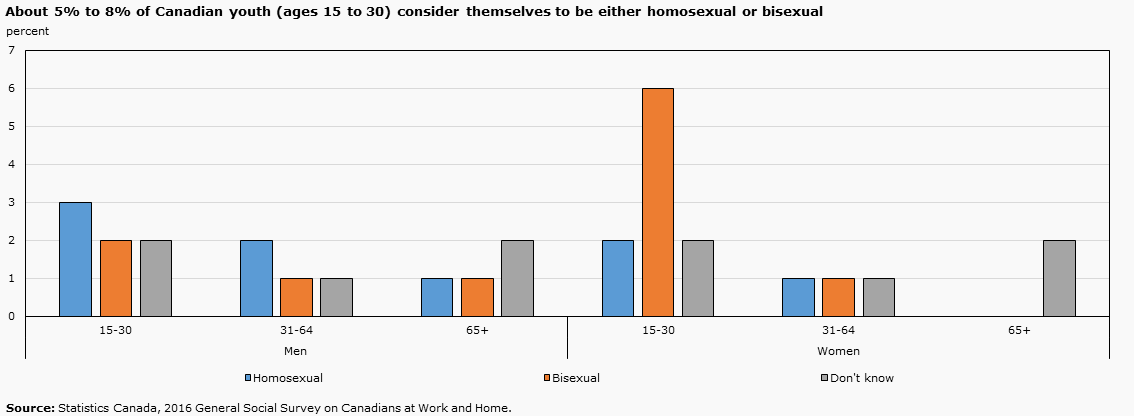
Description for Chart 8
| Men | Women | |||||
|---|---|---|---|---|---|---|
| Age | ||||||
| 15-30 | 31-64 | 65+ | 15-30 | 31-64 | 65+ | |
| Source: Statistics Canada, 2016 General Social Survey on Canadians at Work and Home. | ||||||
| Homosexual | 3% | 2% | 1% | 2% | 1% | 0% |
| Bisexual | 2% | 1% | 1% | 6% | 1% | 0% |
| Don't know | 2% | 1% | 2% | 2% | 1% | 2% |
The number of young Indigenous people is growing
From 2006 to 2016, the number of First Nations, Métis and Inuit youth aged 15 to 30 increased by 39%, compared to just over 5% for non-Indigenous youth.
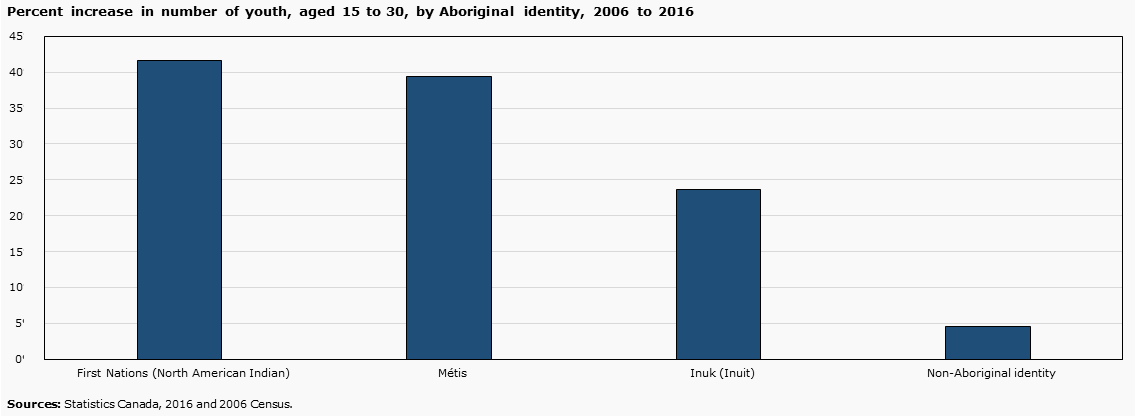
Description for Chart 9
| Aboriginal identity | Percent increase in number of youth |
|---|---|
| Sources: Statistics Canada, 2016 and 2006 Census. | |
| First Nations | 41% |
| Métis | 39% |
| Inuit | 24% |
| Non-Indigenous | 5% |
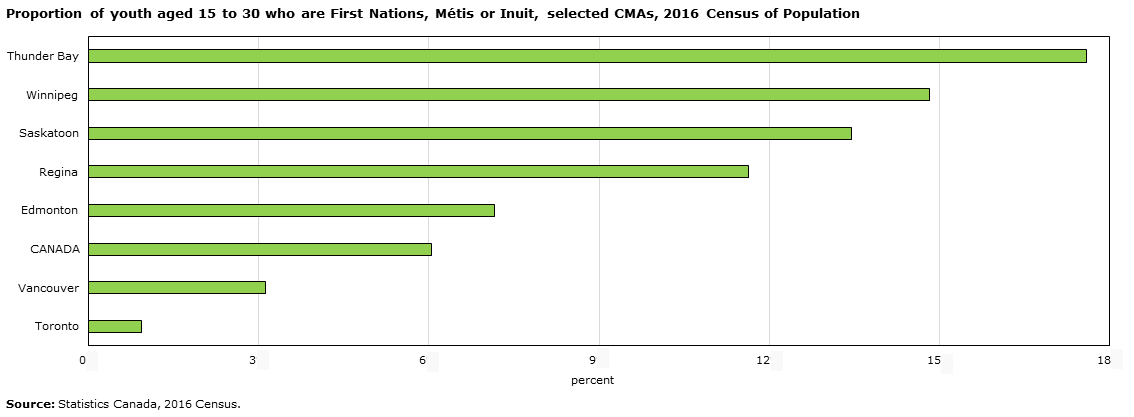
Description for Chart 10
| Percentage of youth | |
|---|---|
| Source: Statistics Canada, 2016 Census. | |
| Toronto | 1 |
| Vancouver | 3 |
| Canada | 6 |
| Edmonton | 7 |
| Regina | 12 |
| Saskatoon | 13 |
| Winnipeg | 15 |
| Thunder Bay | 18 |
More youth are living with their parents
In 2016, 57% of youth aged 15 to 30, were living with their parents, which is practically unchanged from 56% in 2001.
However, the largest increase was for youth aged 27 to 30 years old. 22% were living with their parents in 2016 compared to 18% in 2001. This varied significantly by CMA.
| Census metropolitan area | Percent (%) |
|---|---|
| Sources: Statistics Canada, 2016 and 2001 Census | |
| Toronto | 36 |
| Hamilton | 30 |
| Vancouver | 28 |
| Canada | 22 |
| Montréal | 19 |
| Calgary | 16 |
| Québec | 9 |
What are Canadian youth doing?
Youth are more connected than any other generation
- Nearly 100% of youth aged 15 to 30 use the Internet on a daily basis or own their own smartphone – broadly similar across all provinces and across all household income groups.
- 77% of youth aged 15 to 30 use the Internet to follow news and current affairs.
- One half of youth aged 25 to 30 conduct transactions on the Internet at least weekly – almost twice that of older Canadians.
- 93% of youth aged 15 to 30 use social networking sites.

Description for Chart 11
| Age | Percent |
|---|---|
| Note: Includes only those that reported using the Internet. Source: Statistics Canada, General Social Survey, 2013. |
|
| 15 to 30 | 93 |
| 31 to 44 | 79 |
| 45 to 54 | 58 |
| 55 to 64 | 52 |
| 65+ | 36 |
But higher technology use also brings new challenges
17% of youth aged 15 to 30 said they were cyberbullied or cyberstalked in the past 5 years.
Youth are less likely to vote but are still socially and civically engaged
Giving, volunteering and participating
- 67% of 15 to 30 years olds are members of a group, organization or association, compared with 65% for the overall Canadian population.
- 48% of youth aged 15 to 30 volunteer.
- 71% of those aged 15 to 30 said they gave to a charitable or non-profit organization.
- 45% of youth aged 15 to 30 have confidence in Canadian Parliament, compared with 38% for the general population.
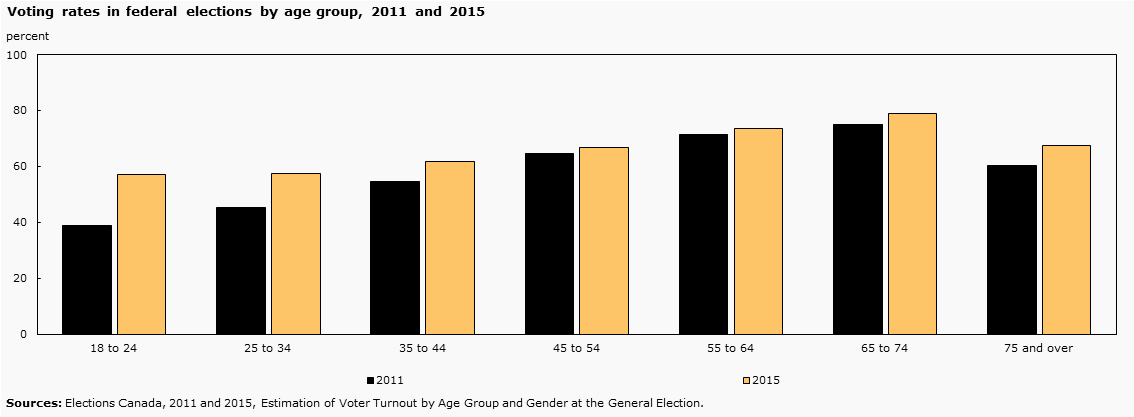
Description for Chart 12
| Age | 2011 | 2015 |
|---|---|---|
| Sources: Elections Canada, 2011 and 2015, Estimation of Voter Turnout by Age Group and Gender at the General Election. | ||
| 18 to 24 | 38.8 | 57.1 |
| 25 to 34 | 45.1 | 57.4 |
| 35 to 44 | 54.5 | 61.9 |
| 45 to 54 | 64.5 | 66.6 |
| 55 to 64 | 71.5 | 73.7 |
| 65 to 74 | 75.1 | 78.8 |
| 75 and over | 60.3 | 67.4 |
Did you know?
The proportion of young people aged 15 to 30 who stated that they rarely or never followed news and current affairs almost doubled, from 12% in 2003 to 23% in 2013.
Youth aged 15 to 30 contribute 23% of all volunteer hours in Canada.
Youth participate actively in sports, arts and cultural activities
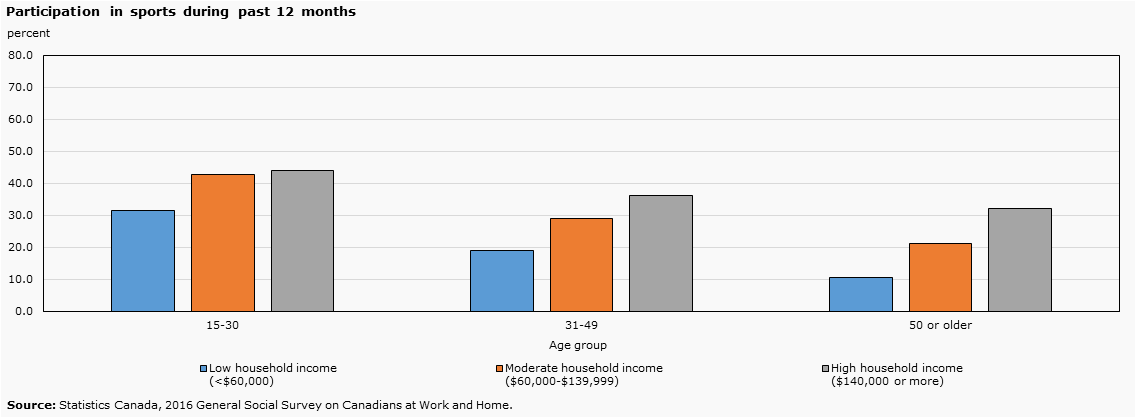
Description for Chart 13
| Household income | age 15-30 | age 31-49 | age 50 or older |
|---|---|---|---|
| % | |||
| Low household income (<$60,000) | 31.3 | 18.8 | 17.1 |
| Moderate household income ($60,000-$139,999) | 42.5 | 29.0 | 21.2 |
| High household income ($140,000 or more) | 43.9 | 36.3 | 32.1 |
| Sources: Statistics Canada, 2016 General Social Survey on Canadians at Work and Home. | |||

Description for Chart 14
| Household income | 15-30 | 31-49 | 50 or older |
|---|---|---|---|
| % | |||
| Low household income (<$60,000) | 56.3 | 50.4 | 46.1 |
| Moderate household income ($60,000-$139,999) | 58.4 | 47.5 | 47.1 |
| High household income ($140,000 or more) | 63.8 | 47.1 | 50.2 |
| Sources: Statistics Canada, 2016 General Social Survey on Canadians at Work and Home. | |||
Youth are more educated than ever
- 97% of 15 year olds attend school
- 5% of 21 year olds enroll in apprenticeship programs
- 24% of 19 year olds in college
- 36% of 21 year olds at university

Description for Chart 15
| Year | Men | Women | ||
|---|---|---|---|---|
| College | BA or higher | College | BA or higher | |
| Sources: Statistics Canada, 1990 to 2018 Labour Force Survey. | ||||
| 1990 | 15.3 | 15.2 | 18.9 | 14.8 |
| 1997 | 20.3 | 22.2 | 26.6 | 24.5 |
| 2007 | 22.7 | 23.8 | 28.6 | 33.1 |
| 2017 | 21.6 | 30.5 | 27.5 | 42.7 |
Did you know?
A large gap in postsecondary enrolment remains between youth from lower and higher income families. Non-financial factors, such as academic performance and parental education, play a significant role.
In 2016, 9% of men and 5% of women aged 25 to 34 had not completed high school, compared to 22% and 19%, respectively, in 1990. In 2011, 31% of Indigenous men and 25% of Indigenous women had not completed high school.
Young men and women continue to enter different types of programs and fields of study
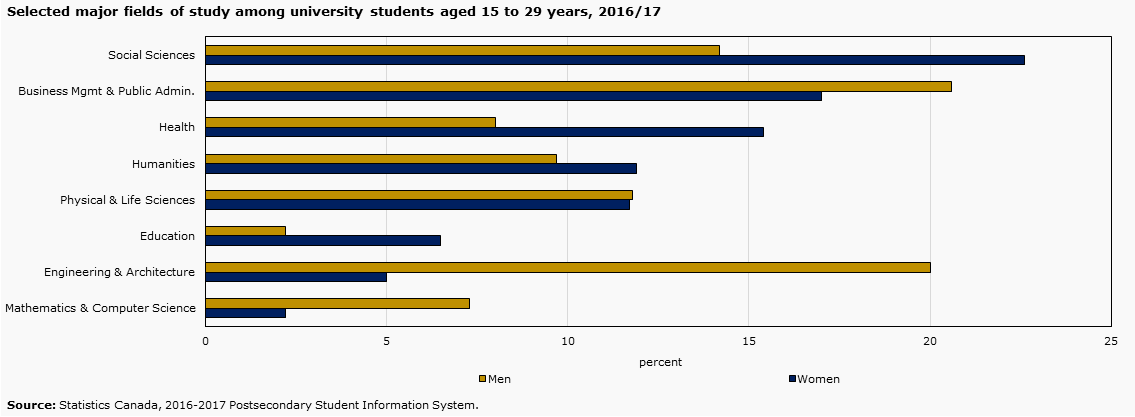
Description for Chart 16
| Selected field of study | Men | Women |
|---|---|---|
| % | ||
| Source: Statistics Canada, 2016-2017 Postsecondary Student Information System. | ||
| Mathematics & Computer Science | 7.3 | 2.2 |
| Engineering & Architecture | 20.0 | 5.0 |
| Education | 2.2 | 6.5 |
| Physical & Life Sciences | 11.8 | 11.7 |
| Humanities | 9.7 | 11.9 |
| Health | 8.0 | 15.4 |
| Business Mgmt & Public Admin. | 20.6 | 17.0 |
| Social Sciences | 14.2 | 22.6 |
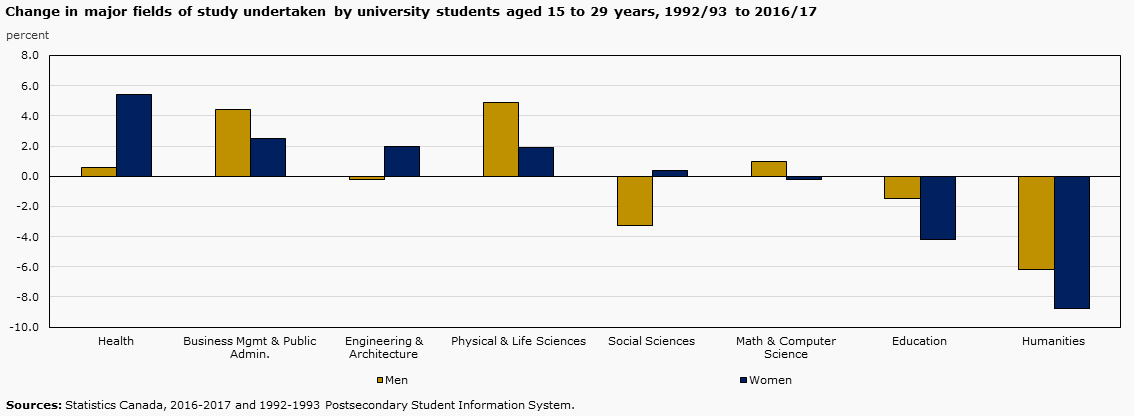
Description for Chart 17
| Field of study | Men | Women |
|---|---|---|
| percentage points | ||
| Sources: Statistics Canada, 2016-2017 and 1992-1993 Postsecondary Student Information System | ||
| Health | 0.6 | 5.4 |
| Business management and public administration | 4.4 | 2.5 |
| Engineering and architecture | -0.2 | 2 |
| Physical and life sciences | 4.9 | 1.9 |
| Social sciences | -3.3 | 0.4 |
| Mathematics and computer science | 1 | -0.2 |
| Education | -1.5 | -4.2 |
| Humanities | -6.2 | -8.8 |
Did you know?
Literacy and numeracy scores are higher among 15 to 29 year olds than any other age group.
Lifetime earnings vary considerably across educational attainment and fields of study
Among youth from the early 1990s, average cumulative earnings through their thirties and forties were over $700,000 higher among men with a bachelor's degree than among men with a high school diploma. Among women, the difference was $442,000.
These results varied significantly by field of study:
- Men with an engineering degree made over 50% more than men with a degree in the humanities.
- Women in mathematics, physical sciences and business administration made 25% more than women in the social sciences.
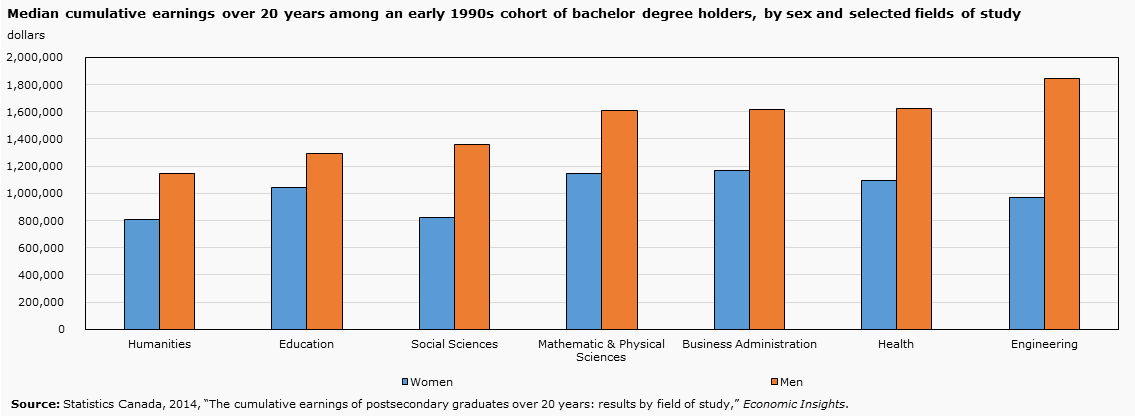
Description for Chart 18
| Field of study | Women | Men |
|---|---|---|
| Sources: Statistics Canada, Longitudinal Worker File and 1991 Census. | ||
| Humanities | $808,200 | $1,144,600 |
| Education | $1,044,600 | $1,290,400 |
| Social Sciences | $824,300 | $1,358,900 |
| Mathematic & Physical Sciences | $1,148,700 | $1,607,500 |
| Business Administration | $1,169,100 | $1,619,400 |
| Health | $1,094,000 | $1,627,600 |
| Engineering | $972,600 | $1,845,000 |
Costs of education have increased and many graduates continue to be burdened with debt
- Average tuition fees for full-time Canadian undergraduate students increased faster than the rate of inflation over the last decade.
- Average tuition fees for full-time Canadian undergraduate students are lowest in Newfoundland and Labrador and Quebec, and highest in Ontario and Nova Scotia.
- 53% of youth aged 15 to 30 years graduating with a bachelor's degree have student debts, similar to the early 2000s.

Description for Chart 19
| Percentage of graduates with student debts | Average debt at graduation | |
|---|---|---|
| Source: Statistics Canada, 2014, "The cumulative earnings of postsecondary graduates over 20 years: results by field of study," Economic Insights. | ||
| College | 51% | $15,000 |
| Bachelor's | 53% | $25,600 |
| Master's | 53% | $27,900 |
| Doctorate | 54% | $47,000 |
How are Canadian youth doing?
Fewer young men in full-time or permanent jobs...resulting in lower earnings at the middle and lower end of the earnings distribution

Description for Chart 20
| 1976 | 2018 | |
|---|---|---|
| Note: Note: Full-time students excluded. Full-time employment refers to 30 hours or more per week. Due to data limitations, individuals are aged 25-29 in 1989. Sources: 1989, General Social Survey and Labour Force Survey (March and September files). |
||
| Men 25-30 | 89.8 | 81.4 |
| Women 25-30 | 43.5 | 67.5 |
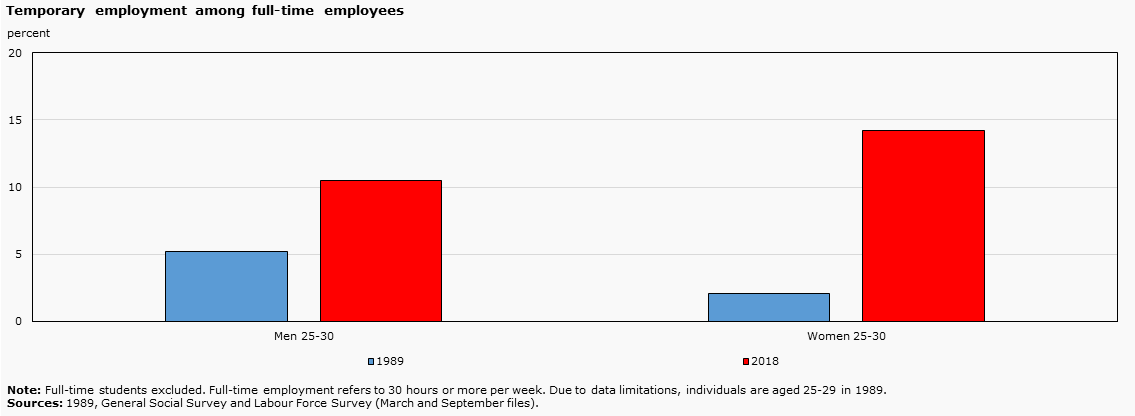
Description for Chart 21
| 1989 | 2018 | |
|---|---|---|
| Note: Note: Full-time students excluded. Full-time employment refers to 30 hours or more per week. Due to data limitations, individuals are aged 25-29 in 1989. Sources: 1989, General Social Survey and Labour Force Survey (March and September files). |
||
| Men age 25-30 | 5.2% | 10.5% |
| Women age 25-30 | 2.1% | 14.2% |
Did you know?
The percentage of young women employed full-time rose because of their growing labour force participation.

Description for Chart 22
| 25th percentile | 50th percentile | 75th percentile | |
|---|---|---|---|
| Source: Statistics Canada, 2018, "Wages for young workers up to the age of 40," Analytical Studies Branch Research Paper Series. | |||
| 1978-1989 | 410,132.35 | 657,688.93 | 874,524.59 |
| 1986-1997 | 327,423.86 | 583,688.29 | 820,667.53 |
| 1996-2007 | 322,251.22 | 564,526.55 | 830,784.11 |
| 2004-2015 | 342,202.93 | 601,113.96 | 906,023.33 |
Did you know?
Young men and women at the top of the earnings distribution are faring better than ever.

Description for Chart 23
| 25th percentile | 50th percentile | 75th percentile | |
|---|---|---|---|
| Source: Statistics Canada, 2018, "Wages for young workers up to the age of 40," Analytical Studies Branch Research Paper Series. | |||
| 1978-1989 | 165,060.49 | 355,220.91 | 547,649.75 |
| 1986-1997 | 168,180.88 | 356,129.43 | 549,798.67 |
| 1996-2007 | 190,676.52 | 382,820.83 | 602,025.03 |
| 2004-2015 | 211,459.83 | 417,950.74 | 668,313.14 |
Did you know?
In contrast to young men, young women have significantly increased their annual hours of work and moved to better-paid occupations, resulting in higher cumulative earnings.
Some of the occupations in which youth are working
Among employed women aged 15 to 30...
- ...about 19% worked in professional occupations such as nurses, teachers and accountants.
- ...about 14% worked in technical and paraprofessional occupations such as paralegals and health technicians.
- ...about 14% worked in administrative occupations such as office administrators.
- ...about 28% worked in personal and customer service occupations, such as food and beverage servers and information services representatives.
- ...about 19% worked in sales occupations, such as cashiers and retail salespersons.
Among employed men aged 25 to 34...
- ...about 13% worked in professional occupations such as computers and IT professionals, accountants and engineers.
- ...about 9% worked in technical and paraprofessional occupations such as computer tech support, firefighters and police officers.
- ...about 15% worked in industrial and construction occupations, such as electricians, carpenters and mechanics.
- ...about 18% worked in personal and customer service occupations, such as cooks and food and beverage servers.
- ...about 15% worked in sales occupations, such as retail salespersons and store shelf stockers, clerks and order fillers.
Source: Statistics Canada, 2018 Labour Force Survey.
Some groups are more likely to be overqualified than others

Description for Chart 24
| Percent | |
|---|---|
| All men | 17.7 |
| All women | 18.3 |
| Immigrant men with a degree from outside Canada or the U.S. | 34.8 |
| Immigrant women with a degree from outside Canada or the U.S. | 43.0 |
| Source: Source: Statistics Canada, 2011 National Household Survey. | |
Low-income rates among Canadians aged 25 to 30
| Percent | |
|---|---|
| Total | 13.1 |
| Not residing with any family members | 27.9 |
| Aboriginal people off-reserve | 21.4 |
| With a disability | 22.4 |
Did you know?
In 2014, 6.6% of young Canadians aged 15 to 30 reported that they had ever temporarily lived with family, friends, in their car, or anywhere else because they had nowhere else to live – a situation referred to as 'hidden' or 'concealed' homelessness.
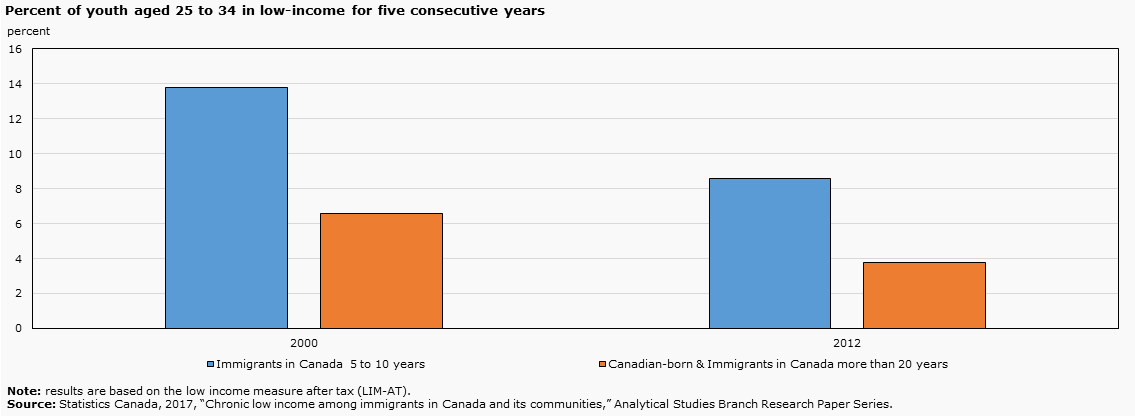
Description for Chart 25
| 2000 | 2012 | |
|---|---|---|
| Note: results are based on the low income measure after tax (LIM-AT). Sources: Statistics Canada, Canadian Income Survey, 2015; General Social Survey on Canadians' Safety (Victimization), 2014; Longitudinal Immigration Database. |
||
| Immigrants in Canada 5 to 10 years | 14% | 9% |
| Canadian-born & Immigrants in Canada more than 20 years | 7% | 4% |
Homeownership among youth recently declined for the first time in 20 years
- Homeownership among younger adults aged 20 to 29 remained significantly lower than for older Canadians.
- Between 2006 and 2016, homeownership rates declined across all age groups, except for those aged 65 years old and over. This follows several decades of gradual increase. The decline was largest for younger adults, particularly over the past 5 years.
- Coincides with other broader trends such as the rising share of youth who are living with their parents, delays in starting a family, and the increase in housing costs.

Description for Chart 26
| 2006 | 2011 | 2016 | |
|---|---|---|---|
| % | |||
| Sources: Statistics Canada, 2011 National Household Survey and 2006 and 2016 Census of Population. | |||
| 20 to 29 years old | 34.9 | 37.5 | 33.5 |
| 30 to 64 years old | 72.2 | 72.1 | 70.2 |
| 65 years old and over | 72.2 | 73.6 | 74.6 |
One-quarter of youth with severe disability say they have been refused a job because of their condition
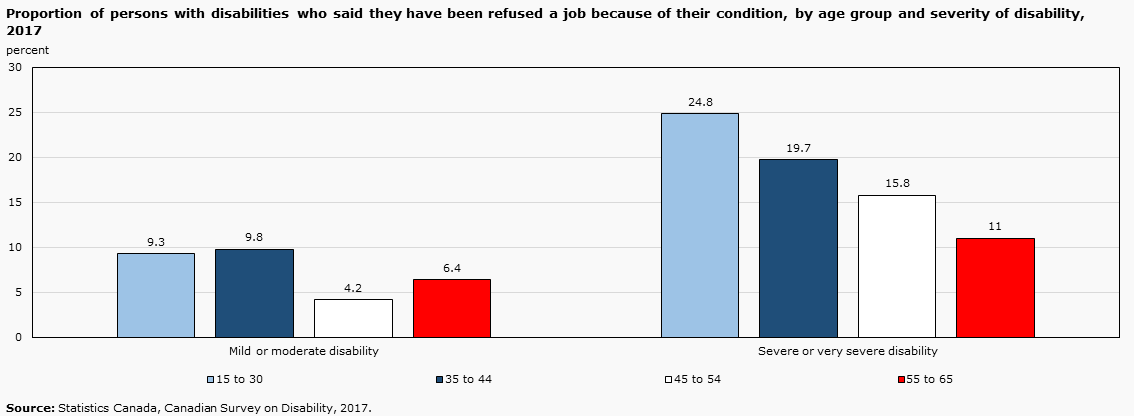
Description for Chart 27
| Age | Mild or moderate disability | Severe or very severe disability |
|---|---|---|
| % | ||
| 15 to 30 | 9.3 | 24.8 |
| 35 to 44 | 9.8 | 19.7 |
| 45 to 54 | 4.2 | 15.8 |
| 55 to 64 | 6.4 | 11 |
| Source: Statistics Canada, Canadian Survey on Disability, 2017 | ||
Did you know?
887,730 youth aged 15 to 30 – or 13% – report that they have a disability (whether it be physical, sensory, cognitive, or mental health-related).
Youth aged 15 to 30 are more likely to report that they experienced discrimination
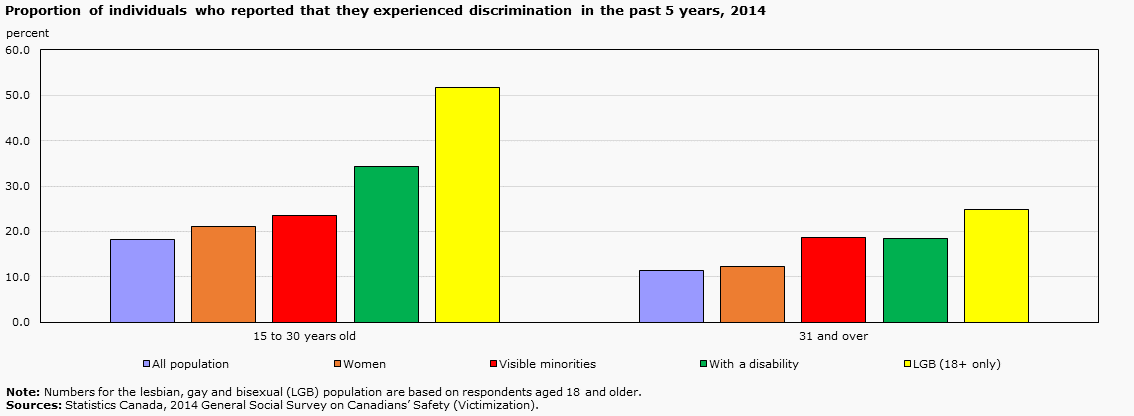
Description for Chart 28
| Age 15 to 30 | Age 31 and over | |
|---|---|---|
| % | ||
| All population | 18.3 | 11.5 |
| Women | 21.1 | 12.3 |
| Visible minorities | 23.4 | 18.6 |
| With a disability | 34.2 | 18.4 |
| LGB (18+ only) | 51.7 | 24.8 |
| Note: Numbers for the lesbian, gay and bisexual (LGB) population are based on respondents aged 18 and older. Sources: Statistics Canada, 2014 General Social Survey on Canadians' Safety (Victimization). |
||
Did you know?
In 2016, 16% of young men and 12% of young women reported experiencing at least one aspect of social isolation. Results were broadly similar across all youth and compared with older adults.
Some young men and women face serious mental health problems
- Rates of mood disorder are highest among youth aged 15 to 30 compared to other age groups: young women in particular have the highest rate (12%).
- Approximately 60% of youth who have experienced mood disorder have also had suicidal thoughts in their lifetime.
- Suicide is the second leading cause of death among youth aged 15 to 29.
- 15.7 deaths per 100,000 for young men
- 6.7 deaths per 100,000 for young women
- Approximately half (53%) of youth with depression or suicidal thoughts have sought professional support.
Sources: Statistics Canada, 2014 Vital Statistics and 2012 Canadian Community Health Survey – Mental Health.
Indigenous youth are particularly at risk for poor mental health
- 15.4% of off-reserve First Nations and 18.5% of Metis youth aged 15 to 30 report having a mood disorder.
- Rates of acute care hospitalizations for intentional self-harm are high among Aboriginal youth age 15 to 30.
- 64 per 100,000 for First Nations youth living on-reserve
- 42 per 100,000 for First Nations youth living off-reserve
- 20 per 100,000 for Metis youth
- 90 per 100,000 for Inuit youth
Sources: Statistics Canada, 2015-2017 Canadian Community Health Survey, 2011 National Household Survey; and CIHI 2011-2016 Discharge Abstract Database.
High rates of obesity and physical inactivity put youth at risk for heart disease later in life
The share of youth 15-30 who are overweight or obese increased significantly since the late 1970s–from 24% to about 40% in the early 2000s. The share has remained stable over the last decade.
Youth are also not meeting physical activity guidelines–only 1 in 5 are meeting the recommended 150 minutes of physical activity per week.
Only 22% of young men and 32% of young women (aged 15-30) consume the recommended 5 servings of fruits and vegetables per day.
These factors are potentially putting youth at risk of cardiovascular disease later in life.
Based on a new CanHeart Index which measures risk factors for heart disease including diet, weight and physical activity, approximately 1 in 4 youth aged 20-29 rank as having poor heart health.
Sources: Statistics Canada, 2017 Canadian Community Health Survey, 2014-2015 Canadian Health Measures Survey and 1978 Canadian Health Survey.
Drinking, smoking, and cannabis use by young people have generally declined...but new challenges are emerging
- Smoking rates for both young men and women have dropped significantly since the early 2000s.
- Heavy drinking by young men has also declined, but has increased for young women.
- While cannabis use is still generally higher among youth compared to older Canadians, it has generally decreased for youth.
Today's youth are dealing with the challenges of new drugs and addictions
- Opioid-related hospitalization rates rise fastest among youth.
- Rate of hospital based opioid events increased by 27% in the last 5 years (CIHI, 2018).
- Rates of opioid related hospitalizations are up to 5 times higher among Indigenous youth and 2 times higher among lower income households.
Opioid hospitalizations by income

Description for Chart 29
| Household income | Rate of hospitalization |
|---|---|
| 1 (lowest) | 18.0 |
| 2 | 10.2 |
| 3 | 8.1 |
| 4 | 7.3 |
| 5 (highest) | 9.0 |
| Sources: Statistics Canada, 2011 National Household Survey, 2011-2016 Discharge Abstract Database and 2011-2016 Canadian Vital Statistics Deaths databases. | |
Did you know?
Daily or occasional smoking dropped from 31% of young men aged 15 to 30 in 2003 to about one fifth in 2017. For young women, about 14% reported smoking in 2017 compared to 26% in 2003. Heavy drinking for males aged 15 to 30 was 31% in 2017, down from almost 40% in 2003. Heavy drinking for young women increased from 19% in 2003 to 24% in 2017.
Youth are more likely to commit crimes...but also more likely to be victims of violent crimes
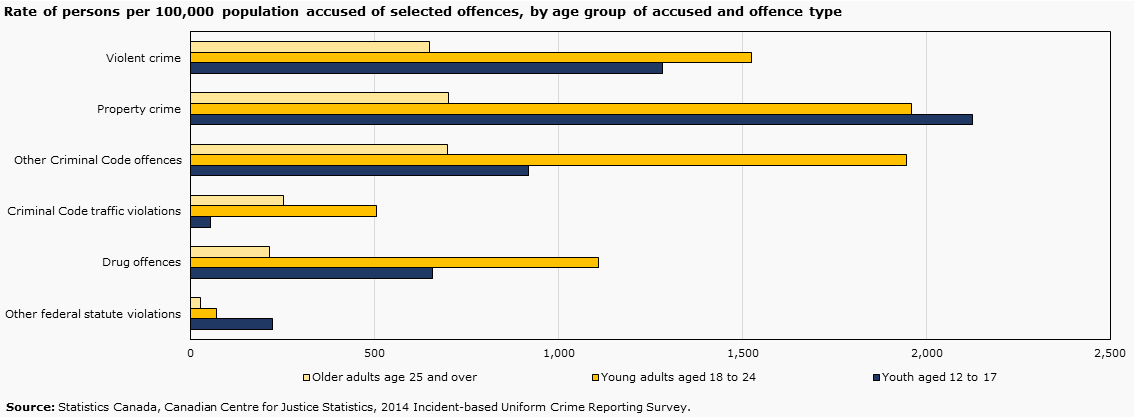
Description for Chart 30
| Offence type | Older adults aged 25 and older | Young adults aged 18 to 24 | Youth aged 12 to 17 |
|---|---|---|---|
| Other federal statute violations | 25 | 71 | 221 |
| Drug offences | 215 | 1,108 | 657 |
| Criminal Code traffic violations | 252 | 506 | 53 |
| Other Criminal Code offences | 699 | 1,945 | 918 |
| Property crime | 701 | 1,959 | 2,124 |
| Violent crime | 649 | 1,524 | 1,281 |
| Sources: Statistics Canada, Canadian Centre for Justice Statistics, Incident-based Uniform Crime Reporting Survey, 2014. General Social Survey (Victimization), 2014. | |||
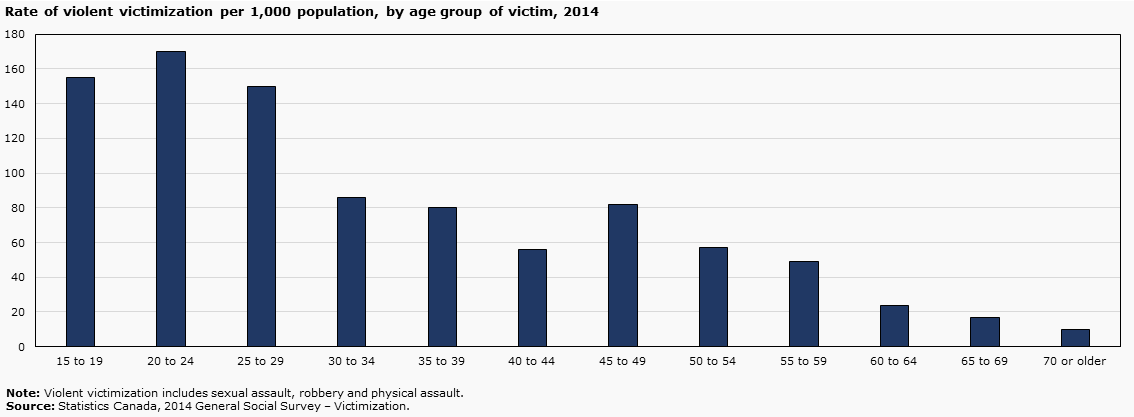
Description for Chart 31
| Age | Rate per 1,000 population |
|---|---|
| 15 to 19 | 155 |
| 20 to 24 | 170 |
| 25 to 29 | 150 |
| 30 to 34 | 86 |
| 35 to 39 | 80 |
| 40 to 44 | 56 |
| 45 to 49 | 82 |
| 50 to 54 | 57 |
| 55 to 59 | 49 |
| 60 to 64 | 24 |
| 65 to 69 | 17 |
| 70 or older | 10 |
| Note: Violent victimization includes sexual assault, robbery and physical assault. Source: Statistics Canada, 2014 General Social Survey – Victimization. |
|
What's next?
Not the end of the story... let's talk
- Canada's youth continue to be a large and important group within the Canadian population.
- They are more diverse, educated, and connected and socially engaged than past youth, and in many ways are well positioned to succeed in today's complex global society.
- In many ways they are very different from younger generations before them…and from their parents and grandparents today.
- But not all young people are sharing these benefits. Some youth are unemployed or are in temporary jobs. Some are struggling with mental health challenges, addictions, and homelessness. And not everyone feels included.
- Date modified:
